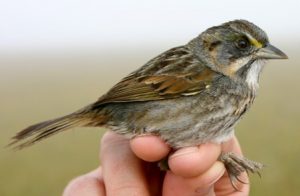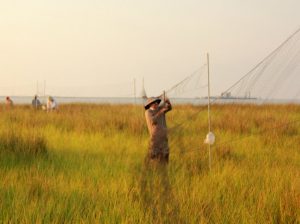Study Finds Seaside Sparrows Change Food Sources in Response to Environmental Stressors
– JUNE 7, 2018
Researchers analyzed the resource use of Seaside Sparrows residing in salt marshes impacted by large-scale disturbances like Deepwater Horizon and Hurricane Isaac to understand the effects on these indicators of ecological change. Over a period of four years, the Seaside Sparrows’ food web pathways remained relatively stable despite observed prey population declines after the oil spill. The Sparrows exhibited a slight shift towards aquatic foods and away from terrestrial foods and occupied a slightly lower trophic position in 2013 and 2014 compared to earlier years. The Seaside Sparrows’ ability to shift between these food resources suggests trophic flexibility, which may allow it to thrive in the highly dynamic environments. The researchers published their findings in Ecosphere: Seaside Sparrows reveal contrasting food web responses to large‐scale stressors in coastal Louisiana saltmarshes.
Coastal marshes along the Gulf Coast are fragile and sensitive and yet are remarkably resilient ecosystems. Disturbances such as oil spills and hurricanes can alter the energy flow through food webs by changing the availability of prey resources and trophic interactions, which can lead to individual- and population-level effects in subsequent generations.
To improve our understanding of how Seaside Sparrows responded to changes in prey populations following the Deepwater Horizon, this study’s team collected tissue samples from bird, plant, and animal consumers (fiddler crabs, snails, ribbed muscles, and terrestrial arthropods) in oiled and unoiled plots in Barataria Bay, Louisiana in 2011, 2012, 2013 and 2014. They analyzed the samples for fatty acids and stable isotopes – variants of chemical elements that do not change– to trace the initial food source and document the natural flow of energy through the food web.
“The use of stable isotopes and fatty acids to study resource use of animals is not uncommon; however, our study was the first use of these tools to better understand the ecology of this salt marsh specialist bird,” explained study author Jill Olin. “It allowed us to discover something that I don’t think any of us would have specifically thought to investigate, which again highlights how important it is to understand the salt marsh as a whole, and in a larger context than just the Deepwater Horizon spill.”
The stable isotope values in primary producers and invertebrate consumers did not differ between oiled and unoiled sites, suggesting that the Sparrows exhibit trophic generalism when resources become compromised. However, some intermediate invertebrates and arthropods exhibited significant temporal and spatial differences between 2013 and 2014. Hurricane Isaac in 2012 and its storm surge likely triggered a shift towards aquatic resources as species dominant in Sparrow diets may have died or moved out. The hurricane also likely increased Sparrow exposure to oil compounds in the marsh sediment.
“Seaside Sparrows were likely able to avoid oiled areas where prey populations were depleted due to the heterogeneous distribution of oil across the landscape,” explained Olin. “On the other hand, storm surge from Hurricane Isaac inundated the salt marsh surface, compromising the above-ground food resources (spiders, crickets, and other invertebrates that live on the vegetation). This storm surge accompanied with high winds and heavy rains likely forced the birds to spend more time on the ground foraging for preys that live on or in the sediment. Seaside Sparrows had to forage for different prey items following Hurricane Isaac – an unexpected result,” said Olin.
Characterizing organisms’ trophic response to changes in their environment is important for predicting future ecological responses to stressors. The authors call for further investigations about the relative influences of arthropod community composition and disturbance on salt marsh vertebrate foraging behavior.
“It is difficult to understand all the impacts of the Deepwater Horizon oil spill on the salt marsh,” explained Olin, “because there are still many seemingly ‘basic’ things about the ecology of salt marsh species that we don’t understand well enough. But we have made significant progress on many fronts in the years since the oil spill.”
Data are publicly available through the Gulf of Mexico Research Initiative Information & Data Cooperative (GRIIDC) at doi:10.7266/N7KK98P7, doi:10.7266/N7BV7DPQ, doi:10.7266/N7MC8X3B, and doi:10.7266/N7GM85DF.
The study’s authors are Jill A. Olin, Christine M. Bergeon Burns, Stefan Woltmann, Sabrina S. Taylor, Phillip C. Stouffer, Wokil Bam, Linda Hooper-Bui, and R. Eugene Turner.
************
This research was made possible in part by a grant from the Gulf of Mexico Research Initiative (GoMRI) to the Coastal Waters Consortium (CWC I and CWC II).
The Gulf of Mexico Research Initiative (GoMRI) is a 10-year independent research program established to study the effect, and the potential associated impact, of hydrocarbon releases on the environment and public health, as well as to develop improved spill mitigation, oil detection, characterization and remediation technologies. An independent and academic 20-member Research Board makes the funding and research direction decisions to ensure the intellectual quality, effectiveness and academic independence of the GoMRI research. All research data, findings and publications will be made publicly available. The program was established through a $500 million financial commitment from BP. For more information, visit https://gulfresearchinitiative.org/.
© Copyright 2010-2018 Gulf of Mexico Research Initiative (GoMRI) – All Rights Reserved. Redistribution is encouraged with acknowledgement to the Gulf of Mexico Research Initiative (GoMRI). Please credit images and/or videos as done in each article. Questions? Contact web-content editor Nilde “Maggie” Dannreuther, Northern Gulf Institute, Mississippi State University (maggied@ngi.msstate.edu).







